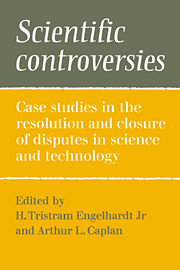 Scientific Controversies
Scientific Controversies Published online by Cambridge University Press: 03 February 2010
In 1973 the American Psychiatric Association Board of Trustees passed a resolution that removed homosexuality per se from the list of mental disorders in the second edition of the association's Diagnostic Manual of Mental Disorders (DSM-II). This decision was made after an acrimonious debate within the association initiated by lobbying efforts by gay activists. In the place of the category of homosexuality was substituted a category called “sexual orientation disturbance” that was for “individuals whose sexual interests are directed primarily toward people of the same sex and who are either disturbed by, in conflict with, or wish to change their sexual orientation.” In a statement supporting the board of trustees' action, I maintained that the revision was “scientifically sound and a reasonable compromise between two extreme viewpoints about homosexuality held by many members of our profession. It avoids commitment to either the notion that homosexuality is invariably a mental disorder or that it is merely a normal variant of heterosexuality.” However, those who opposed the resolution and argued that homosexuality always represents psychopathology regarded the decision as a triumph of politics over science.
It is not surprising that those who had opposed the 1973 decision made no attempt to reopen the question of the classification of homosexuality as a mental disorder when, in 1974, work began on the third edition of the manual (DSM-III) under my leadership as newly appointed chairperson of the APA Task Force on Nomenclature and Statistics. First, these individuals may have assumed that in view of the central role that I played in the 1973 decision, their views would hardly be given a favorable hearing.
To save this book to your Kindle, first ensure no-reply@cambridge.org is added to your Approved Personal Document E-mail List under your Personal Document Settings on the Manage Your Content and Devices page of your Amazon account. Then enter the ‘name’ part of your Kindle email address below. Find out more about saving to your Kindle.
Note you can select to save to either the @free.kindle.com or @kindle.com variations. ‘@free.kindle.com’ emails are free but can only be saved to your device when it is connected to wi-fi. ‘@kindle.com’ emails can be delivered even when you are not connected to wi-fi, but note that service fees apply.
Find out more about the Kindle Personal Document Service.
To save content items to your account, please confirm that you agree to abide by our usage policies. If this is the first time you use this feature, you will be asked to authorise Cambridge Core to connect with your account. Find out more about saving content to Dropbox.
To save content items to your account, please confirm that you agree to abide by our usage policies. If this is the first time you use this feature, you will be asked to authorise Cambridge Core to connect with your account. Find out more about saving content to Google Drive.